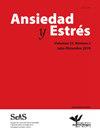Modelo de riesgo suicida transcultural: Evidencias de la capacidad predictiva en dos países de Latinoamérica
IF 0.5
Q4 PSYCHOLOGY, CLINICAL
引用次数: 0
Abstract
Introduction: The prevalence of suicide risk among countries such as Colombia and Mexico, has increased over the years, and parsimonious models with favorable explanatory capacity are required. Objective: To develop a suicide risk model with a cross-cultural predictive capacity based on the clinical variables such as depression, hopelessness, and suicidal ideation, in two Latin American countries. Materials and Method: There was a final sample of 807 Mexican and Colombian adults, 278 men, and 531 women. Scales of hopelessness (IDIS), suicidal ideation (PANSI and IDIS), depression (SDS), and suicidal risk (SRS), were used. Two predictive hypotheses were tested: a) depression is associated with hopelessness and suicidal ideation in the same way in both countries, and b) suicidal ideation predicts suicide risk and is associated with depression and hopelessness. Results: The findings indicated high and significant correlations between the predictor and criterion variables. The model obtained showed a total explained variance of 67% of the suicide risk and 66% for each country. Conclusions: It was verified that the model was invariant between the samples of the two participating countries, which represented new evidence of the cross-cultural utility of the model obtained based on cognitions and affect on suicidal behavior.跨文化自杀风险模型:两个拉丁美洲国家预测能力的证据
引言:哥伦比亚和墨西哥等国的自杀风险患病率近年来有所上升,需要具有良好解释能力的简约模型。目的:基于两个拉丁美洲国家的临床变量,如抑郁、绝望和自杀意念,建立具有跨文化预测能力的自杀风险模型。材料和方法:最终样本为807名墨西哥和哥伦比亚成年人,278名男性,531名女性。采用绝望量表(IDIS)、自杀意念量表(PANSI和IDIS)、抑郁量表(SDS)和自杀风险量表(SRS)。测试了两种预测假设:a)抑郁与绝望和自杀意念以同样的方式在两个国家联系在一起;b)自杀意念预测自杀风险,与抑郁和绝望联系在一起。结果:研究结果显示预测因子和标准变量之间存在高度且显著的相关性。获得的模型显示,自杀风险的总解释方差为67%,每个国家的解释方差为66%。结论:验证了模型在两个参与国的样本之间是不变的,这代表了基于认知和自杀行为影响的模型的跨文化效用的新证据。
本文章由计算机程序翻译,如有差异,请以英文原文为准。
求助全文
约1分钟内获得全文
求助全文

 求助内容:
求助内容: 应助结果提醒方式:
应助结果提醒方式:


